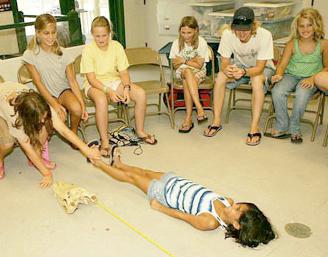Or search by topic
Number and algebra
Geometry and measure
Probability and statistics
Working mathematically
Advanced mathematics
For younger learners
Measure Our Heights



- Problem
- Getting Started
- Student Solutions
- Teachers' Resources
Measure Our Heights


In the second picture the children are trying to measure their heights in a different way, but they are still finding it hard.

This girl is being measured in a different way, with a friend helping her. Do you think measuring using this method looks easy or difficult?
What things in the pictures might they be finding hard?
Can you find a better way to find out the height of a friend?
What will you use? Try it and see how tall they are.
Can you give answers in metres as well as centimetres?
Why do this problem?
This problem gives pupils the opportunity to find ways of measuring friends' heights, trying to avoid difficulties. The questions also encourage them to think about the units they are using.
Possible approach
Talk to the children about measuring heights of people, to find out what experiences they have had. Lead them then to consider the two pictures and the difficulties that the boy and girl are having. Discuss these difficulties and encourage them to offer suggestions as to how they think they could do it more accurately.
If it has not come up naturally, you could then lead the group in a discussion about the units they have used and challenge them to convert centimetres to metres and vice versa.
Key questions
How did you do the measuring?What is that measurement in metres and centimetres? How do you know?
Possible support
Have available as many different pieces of measuring equipment that you can to try and pre-empt the children's methods. Do try to accommodate any unusual requests!You may also like
Hand Span
Use your hand span to measure the distance around a tree trunk. If you ask a friend to try the same thing, how do the answers compare?
Measure for Measure
This article, written for students, looks at how some measuring units and devices were developed.

